For businesses around the globe, Contact Centers represent the heartbeat of their organization: it’s where their two most valued constituencies — employees and customers — intersect and interact. It’s literally a frontline touchpoint that impacts the bottom line of an organization. Faced with a pandemic-driven transformation of the Contact Center landscape, businesses must nimbly address new challenges fueled by employee demands and customer self-empowerment.
The Current Landscape
While society is beginning to recover, our collective “new normal” is still unstable especially in the workplace. Given the war for talent, employees are empowered with the majority opting for better work-life balance, whether that’s remote work, scheduled hours, or shift preferences. Employers are facing far-reaching challenges related to their contact center workforce that include:
- Difficulty hiring strong talent
- High attrition
- Effectiveness of onboarding and ongoing development
- Agent engagement
Meanwhile, customers continue to voice their preferences after being forced through a self-service funnel during much of the pandemic. They prize greater self-service options, proactive issue resolution, personalized service, and are actively engaging with newer technologies like chat, video, and social media.
Contact centers must now balance a new employee dynamic (operating with lean staff and fewer onsite agents) with customer demands (as call volume, hold times, escalations, and difficult calls surge).
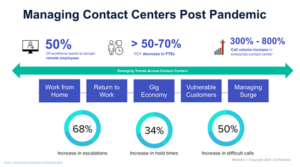
What’s a Business To Do?
In these turbulent times, how does a company navigate a transformed contact center landscape that must adapt to new challenges and demands … from both employees and customers?
Simply put, the organizations that prosper will connect the experiences of customers and employees to understand the cross impact and subsequently drive improvement, identify best practices, and spur business growth.
Collecting customer and agent feedback, giving employees a platform to share ideas, forecasting customer needs, capturing compelling data from both, and using the right dashboards to connect the data will give businesses the following advantage:
The strategic creation of a holistic picture that gets the right data to the right people at the right time to drive meaningful change
Where to Start
Numerous organizations are talking about the importance of connecting employee and customer experience to build an effective hybrid contact center workforce. However, these discussions are still in the early stages with many unsure exactly where to start or how to do it.
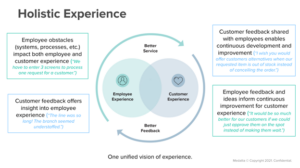
#1: Understand & Connect; Then Address
Actively listen and frequently ask. Frontline agents are a treasure trove of information: unleash the power of their deep and rich customer engagements to understand vulnerabilities and identify valuable workarounds or permanent fixes.
- Use agent notes more often to further identify why customers escalate a complaint, give low satisfaction scores, or leave.
- On the employee front, create opportunities for their voice to be heard – the more frequent the better especially in these rapidly changing times.
- Consider adding pulse surveys to capture real-time feedback or to ask a probing question.
Additionally, identify common or key topics of interest across the two sets of feedback (from employees and customers) and incorporate this intelligence within your analytics.
#2: Uncover Key Irritants
Understand what the most impactful irritants are for customers and employees and fix those first.
- Use surveys, agent notes (unstructured data), and one-on-ones with frontline managers to identify what broken processes or poor technologies agents are dealing with day after day that are never fixed. They tire of making excuses, feel bad they can’t provide a better customer experience, and know it will impact their service score.
- Begin to build a case for the financial impact of uncovering and addressing employee and customer irritants.
Interestingly, a 2021 Medallia Institute/Josh Bersin research study found that companies who are employee experience leaders were 12x more likely to indicate revenue growth of more than 20% over the last year.
#3: Discover What is Really Valued
Salary, benefits, and workplace environment all matter, but dig deeper as it’s critical to understand what employees deeply care about and value. It may be:
- Training and education
- Corporate social responsibility
- Diversity and inclusion or
- How proud they are to work for your company/brand.
In terms of workplace pride, a Medallia Institute research study found that companies that ask for and act on frontline employees’ feedback garner the highest employee Net Promoter® scores.
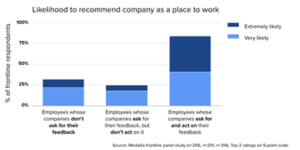
#4: Unite the Two; Use the Data
Many organizations have access to two data sources — one for customers, the other for employees. Is your organization using both independently … or using and connecting both data sources?
It’s critical to de-silo the data and get multiple business units to share and use the data for the common good. Then build dashboards that bring employee data and customer data next to each other to uncover and identify the correlating impact between the two in terms of:
- Topics of interest (customer feedback and employee feedback)
- Driven behaviors (customer behaviors and employee performance)
- Key indicators (customer interaction analytics and employee pulse, agent notes, and 1-2-1 meetings)
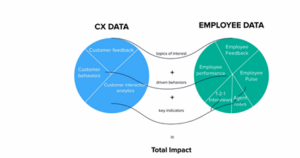
This connection will fuel the delivery of an effective hybrid contact center workforce, while enhancing both employee and customer experience. A holistic approach gives companies the opportunity to create targeted actions to combat workforce challenges, while delivering improved value to customers.
If both experience data sets are leveraged together, the advantages are far-reaching and can generate a significant impact on agent engagement, frontline team effectiveness, customer loyalty, operational efficiencies, product/service innovation, and future revenue.
Interested in learning more? Visit Medallia Experts on Demand to book a 30-minute private meeting with a Medallia Contact Center expert. You can also book meetings directly with Rachel directly.
About Medallia
Medallia is the pioneer and market leader in Experience Management. Medallia’s award-winning SaaS platform, the Medallia Experience Cloud, leads the market in the understanding and management of experience for customers, employees, and citizens. Medallia captures experience signals created on daily journeys in person, digital, and IoT interactions and applies proprietary AI technology to reveal personalized and predictive insights that can drive action with tremendous business results. Using Medallia Experience Cloud, customers can reduce churn, turn detractors into promoters and buyers and create in-the-moment cross-sell and upsell opportunities, providing clear and potent returns on investment. www.medallia.com
Guest post written by: Rachel Lane, Senior Solutions Principal for Contact Centers, Medallia, and originally written on November 30, 2021. To learn more about this and other critical CX topics, register for Execs In The Know’s recent Customer Response Summit and watch the Medallia-led Shop Talk Connecting CX & EX to Deliver an Effective Hybrid Contact Center Workforce on-demand. To access all on-demand content, please register.
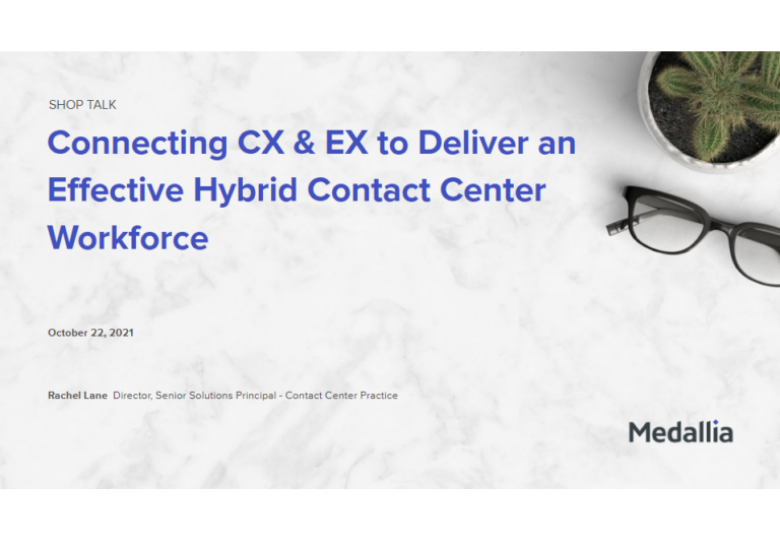





















































 TELUS Digital
TELUS Digital ibex delivers innovative BPO, smart digital marketing, online acquisition technology, and end-to-end customer engagement solutions to help companies acquire, engage and retain customers. ibex leverages its diverse global team and industry-leading technology, including its AI-powered ibex Wave iX solutions suite, to drive superior CX for top brands across retail, e-commerce, healthcare, fintech, utilities and logistics.
ibex delivers innovative BPO, smart digital marketing, online acquisition technology, and end-to-end customer engagement solutions to help companies acquire, engage and retain customers. ibex leverages its diverse global team and industry-leading technology, including its AI-powered ibex Wave iX solutions suite, to drive superior CX for top brands across retail, e-commerce, healthcare, fintech, utilities and logistics.






















 Trista Miller
Trista Miller




























